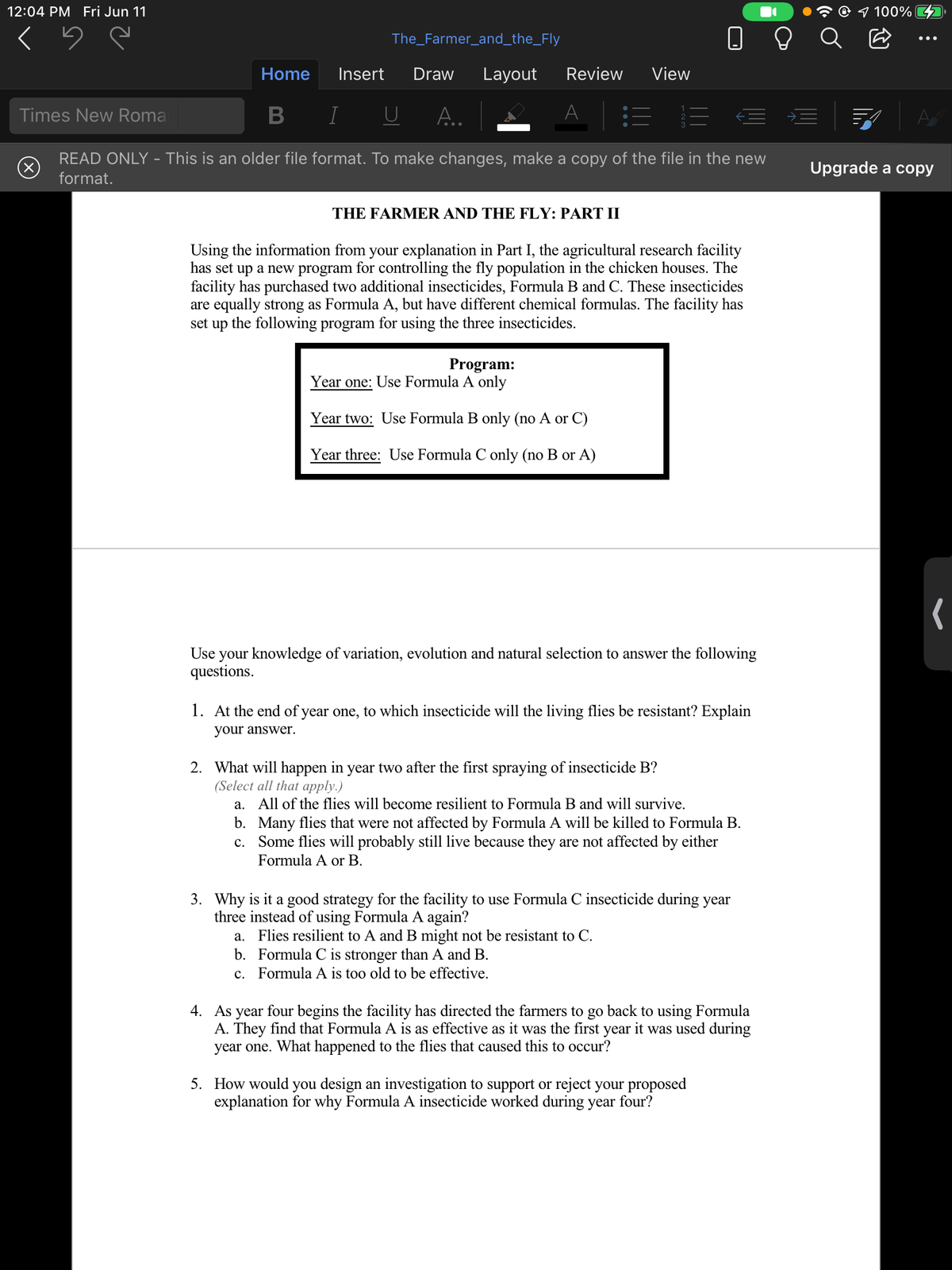THE FARMER AND THE FLY: PART II Using the information from your explanation in Part I, the agricultural research facility has set up a new program for controlling the fly population in the chicken houses. The facility has purchased two additional insecticides, Formula B and C. These insecticides are equally strong as Formula A, but have different chemical formulas. The facility has set up the following program for using the three insecticides. Program: Year one: Use Formula A only Year two: Use Formula B only (no A or C) Year three: Use Formula C only (no B or A) Use your knowledge of variation, evolution and natural selection to answer the following questions. 1. At the end of year one, to which insecticide will the living flies be resistant? Explain your answer.
THE FARMER AND THE FLY: PART II Using the information from your explanation in Part I, the agricultural research facility has set up a new program for controlling the fly population in the chicken houses. The facility has purchased two additional insecticides, Formula B and C. These insecticides are equally strong as Formula A, but have different chemical formulas. The facility has set up the following program for using the three insecticides. Program: Year one: Use Formula A only Year two: Use Formula B only (no A or C) Year three: Use Formula C only (no B or A) Use your knowledge of variation, evolution and natural selection to answer the following questions. 1. At the end of year one, to which insecticide will the living flies be resistant? Explain your answer.
Chapter4: Management Practices For Finfish
Section: Chapter Questions
Problem 1KA
Related questions
Question

Transcribed Image Text:12:04 PM Fri Jun 11
9 100%
The_Farmer_and_the_Fly
Home
Insert
Draw
Layout
Review
View
Times New Roma
I
U
A..
A
READ ONLY - This is an older file format. To make changes, make a copy of the file in the new
format.
Upgrade a copy
THE FARMER AND THE FLY: PART II
Using the information from your explanation in Part I, the agricultural research facility
has set up a new program for controlling the fly population in the chicken houses. The
facility has purchased two additional insecticides, Formula B and C. These insecticides
are equally strong as Formula A, but have different chemical formulas. The facility has
set up the following program for using the three insecticides.
Program:
Year one: Use Formula A only
Year two: Use Formula B only (no A or C)
Year three: Use Formula C only (no B or A)
Use your knowledge of variation, evolution and natural selection to answer the following
questions.
1. At the end of year one, to which insecticide will the living flies be resistant? Explain
your answer.
2. What will happen in year two after the first spraying of insecticide B?
(Select all that apply.)
a. All of the flies will become resilient to Formula B and will survive.
b. Many flies that were not affected by Formula A will be killed to Formula B.
c. Some flies will probably still live because they are not affected by either
Formula A or B.
3. Why is it a good strategy for the facility to use Formula C insecticide during year
three instead of using Formula A again?
a. Flies resilient to A and B might not be resistant to C.
b. Formula C is stronger than A and B.
c. Formula A is too old to be effective.
4. As year four begins the facility has directed the farmers to go back to using Formula
A. They find that Formula A is as effective as it was the first year it was used during
year one. What happened to the flies that caused this to occur?
5. How would you design an investigation to support or reject your proposed
explanation for why Formula A insecticide worked during year four?
Expert Solution
This question has been solved!
Explore an expertly crafted, step-by-step solution for a thorough understanding of key concepts.
This is a popular solution!
Trending now
This is a popular solution!
Step by step
Solved in 2 steps

Knowledge Booster
Learn more about
Need a deep-dive on the concept behind this application? Look no further. Learn more about this topic, biology and related others by exploring similar questions and additional content below.Recommended textbooks for you

